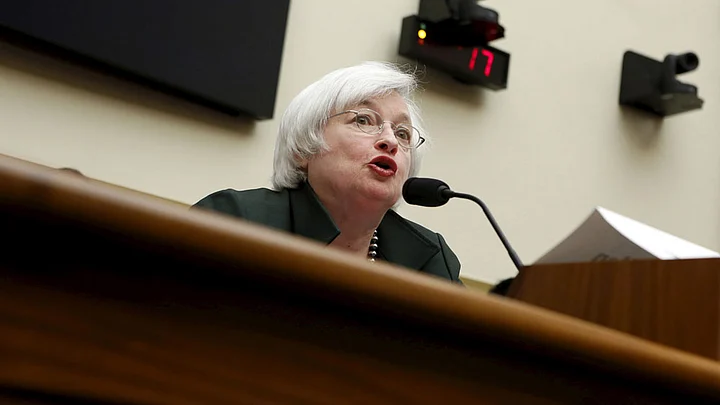On Fed Alert
- Market turmoil latest of many hurdles on road to lift-off
- Markets, economists split on merits of Sept move
- Fed expected to reassure markets, hike or hold
- As threats emerged, central bank stressed ‘gradualism’
The US Federal Reserve, facing this week its biggest policy decision yet under Chair Janet Yellen, puts its credibility on the line regardless of whether it waits or raises interest rates for the first time in nearly a decade.
In a way it is a “damned if you do, damned if you don’t” situation for the Fed despite months of fine-tuning its message, dissecting economic data, and carefully building a consensus around the idea of a cautious and gradual “lift-off” from near zero rates towards levels it considers normal.
A chorus of prominent detractors, including former US Treasury Secretary Lawrence Summers, argues raising rates now would be wrong given market turmoil caused by worries about China‘s economic health and global growth, and the absence of inflation risks at home.
Others say the central bank’s credibility will suffer if it delays the long-telegraphed move and prolongs investors’ guessing game about the timing of the lift-off.
Will Fed Walk the Talk on Interest Rates?
The central bank, for its part, has left the door open to a modest rate rise on Thursday, following a two-day meeting. Recent comments by Fed officials suggest it will try to comfort investors with pledges that whatever it decides it will keep nurturing the economic recovery.
The Fed is anxious to get started. If it were to move I think it would go out of its way to say ... there’s no rush to do anything else. If it doesn’t, it will refer to the market turmoil, and say that ... a rate increase is inevitable
— Scott Minerd, chief investment officer, Guggenheim Partners
Restoring some clarity about the Fed’s intentions will not be easy given how wide apart economists and investors are right now.
A broad group of economists polled by Reuters last week bet on a September move by a slim margin; economists at banks that deal directly with the Fed, known as primary dealers, picked December as more likely; and traders of short term interest rate futures were giving a rate rise this week only a one-in-four chance.
Some say the Fed itself has complicated matters by effectively tearing up its long-scripted lift-off scenario when financial markets wobbled.
First, William Dudley, the influential president of the New York Fed and a permanent voter on policy, told an impromptu news briefing on Aug. 26 that a September rate hike had become “less compelling.”
Then two days later, Fed Vice Chair Stanley Fischer qualified that in a TV interview, saying market volatility could pass and it was too early to judge its significance.
Part of the Problem?
Markets have since calmed somewhat but remain on edge.
I’m growing more sympathetic to those arguing that the Fed has now become a source of market instability, and skipping September will raise the risk of more turmoil all the way through 2016. Only in extreme circumstances should the Fed react to markets. Anything else suggests that they have lost control.
— Eric Neilsen, Global Chief Economist, UniCredit
As recently as July, Yellen, who took over the Fed’s reins in early 2014, appeared to make the case for a September move, telling a congressional hearing that waiting longer could mean the need to hike more rapidly later. “An advantage to beginning a little bit earlier is that we might have a more gradual path,” she said.
Late last month, however, St. Louis Fed President James Bullard, an advocate of a prompt lift-off, told Reuters that while most of his colleagues may have come around to Yellen’s view, market jitters could sway them to hold off.
Yellen, Fischer and Dudley as well as potential swing voters - San Francisco Fed President John Williams and Dennis Lockhart of the Atlanta Fed - are likely to hold the key to this week’s vote.
The Long Road to a Rate Hike
None has sent any clear signals in the past weeks, which may not just reflect concerns about fragile markets, but also uncertainty how the economy and global markets behave in the post-crisis world.
The Fed, which has kept rates at rock bottom since the depths of the recession in late 2008, first flagged its intention to raise rates around mid-2015 as long as three years ago. But even as the world’s largest economy kept outperforming its peers, there has often been something to give policymakers pause.
Inflation has been undershooting the Fed’s forecasts for the past three years. Then a sharp economic slowdown in the first quarter, mainly blamed on harsh winter weather and a rallying dollar, muddied the outlook enough for the Fed to give up on a June lift-off.
Throughout 2015, Yellen and others have puzzled over how an improving labour market was failing to spur stronger wage growth.
Now, with economic growth back at a respectable 3.7 percent clip in the second quarter and unemployment just over 5 percent, half of the crisis-era high, falling commodity prices and an overseas slowdown are pushing inflation further away from the Fed’s 2 percent goal.
Confronted with those uncertainties, the central bank may give up altogether on an “early” hike, in itself a moving target.
That is what the International Monetary Fund, the World Bank, and Summers, who was in the running for Yellen’s job, are publicly advocating. There is just no compelling reason to risk a messy retreat if a rate hike backfired, the argument goes.
The debate has already been settled. It’s later and slower.
— Kevin Logan, Chief US economist, HSBC Securities
(At The Quint, we question everything. Play an active role in shaping our journalism by becoming a member today.)
